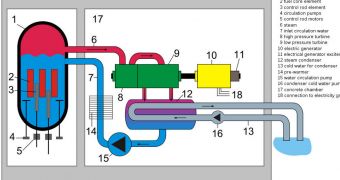As emergency responders struggle to keep three reactors at a Japanese nuclear power plant from going into meltdown, experts are analyzing the chain of events that led to this situation in the first place.
The fact that it happened shows that you can never be too careful when building a nuclear reactor. The incident is currently unfolding in a country that is widely considered to be the best prepared in the world for dealing with events such as this.
Because of its location on the planet, Japan is frequently battered by earthquakes such as the one that struck on March 11, and ranked a magnitude of 9.0. All major constructions and infrastructure are built accordingly, following the most rigorous safety norms.
In spite of the large number of contingency measures in place at the Fukushima Daiichi facility, three of its six boiling-water reactors (BWR) are currently in critical condition. Here is an overview of the factors that led to this situation.
First of all, when the tremor struck, the plant shut down automatically. Control rods came down from the ceilings of the three reactors, and got in between the fuel rods containing radioactive material.
This protection measure functioned flawlessly. However, it only reduces the rate at which radioactive material undergoes nuclear fission. BWR reactors also need active cooling to prevent meltdowns.
This is where things got out of hand. As the tremor struck, the electricity plant providing power to the cooling system pumps was disabled. The next contingency measure kicked in, and the diesel generators began driving said pumps.
About an hour after the earthquake, a large tsunami hit the seaside facility, breaching seawall defenses and damaging the diesel generators as well. The third contingency measure then kicked in. Battery-driven pumps again started driving seawater over the fuel rods in the reactors.
However, there was simply too much residual heat at their cores for these pumps to handle. Steam began building up in excess, and plant operators were forced to vent it into the atmosphere, even if it contained traces of radioactive elements, including iodine and cesium.
But that was not enough either. Explosions started occurring at the reactors because the fuel rods were made of fissionable material encased in the metal zirconium. Reactions between the water and zirconium led to the creation of chemical compounds, including hydrogen.
The three explosions that rocked Fukushima's #1, #2, and #3 reactors were caused when that hydrogen ignited. One of them blew half the roof of reactor #1, but did not destroy the core containment vessel.
Experts explain that the situation is critical at reactor #2, where pumps failed altogether for a short period on Monday, March 14. This led to the total exposure of the fuel rods, which partially melted.
What emergency crews are trying to prevent now is for the melted material to reach the bottom of the containment vessel housing the reactor core. If this happens, there is a great chance that heat from the rods will melt its bottom.
According to analysts, this would result in heavily radioactive material being exposed directly to the atmosphere, which would mean the release of large amounts of radioactive particles in the atmosphere.
“Once that happens the ability to contain the accident is greatly reduced, because the core is liquefied and spreads across the floor,” explains Union of Concerned Scientists physicist Edwin Lyman, quoted by Wired.
Even if crews at Fukushima manage to save the day, the three reactors will become unusable. Salt contained in seawater will forever corrode the reactor core, damaging it beyond repair.
There are currently concerns that Japanese officials may be trying to cover up the extent of the disaster. Officially, they announce the situation is under control, but about 200,000 people were evacuated from the area surrounding the power plant.
At this point, there are no special measures taken for Tokyo, which lies some 250 kilometers (155 miles) away from the nuclear power plant.

 14 DAY TRIAL //
14 DAY TRIAL //